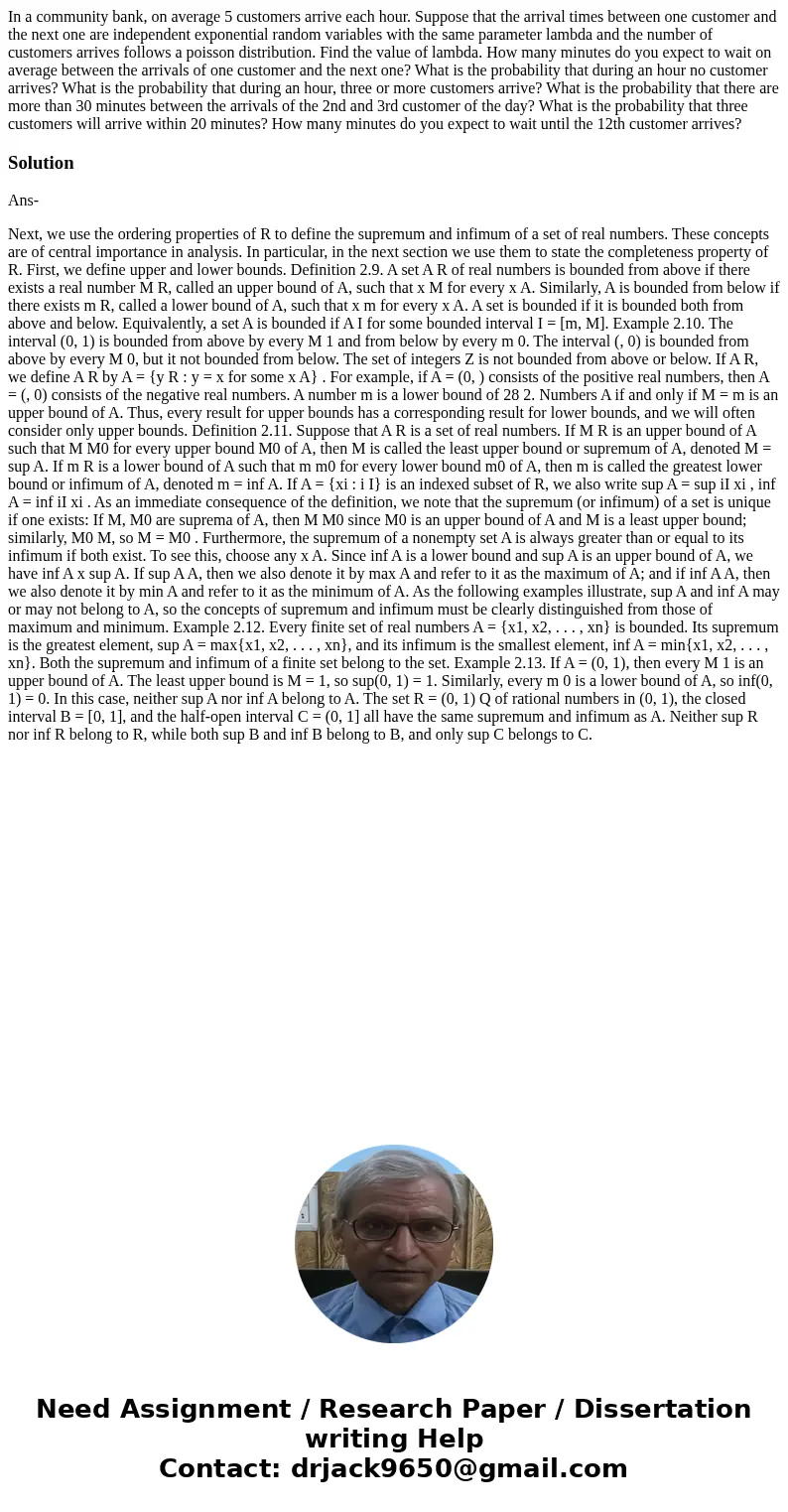In a community bank on average 5 customers arrive each hour
Solution
Ans-
Next, we use the ordering properties of R to define the supremum and infimum of a set of real numbers. These concepts are of central importance in analysis. In particular, in the next section we use them to state the completeness property of R. First, we define upper and lower bounds. Definition 2.9. A set A R of real numbers is bounded from above if there exists a real number M R, called an upper bound of A, such that x M for every x A. Similarly, A is bounded from below if there exists m R, called a lower bound of A, such that x m for every x A. A set is bounded if it is bounded both from above and below. Equivalently, a set A is bounded if A I for some bounded interval I = [m, M]. Example 2.10. The interval (0, 1) is bounded from above by every M 1 and from below by every m 0. The interval (, 0) is bounded from above by every M 0, but it not bounded from below. The set of integers Z is not bounded from above or below. If A R, we define A R by A = {y R : y = x for some x A} . For example, if A = (0, ) consists of the positive real numbers, then A = (, 0) consists of the negative real numbers. A number m is a lower bound of 28 2. Numbers A if and only if M = m is an upper bound of A. Thus, every result for upper bounds has a corresponding result for lower bounds, and we will often consider only upper bounds. Definition 2.11. Suppose that A R is a set of real numbers. If M R is an upper bound of A such that M M0 for every upper bound M0 of A, then M is called the least upper bound or supremum of A, denoted M = sup A. If m R is a lower bound of A such that m m0 for every lower bound m0 of A, then m is called the greatest lower bound or infimum of A, denoted m = inf A. If A = {xi : i I} is an indexed subset of R, we also write sup A = sup iI xi , inf A = inf iI xi . As an immediate consequence of the definition, we note that the supremum (or infimum) of a set is unique if one exists: If M, M0 are suprema of A, then M M0 since M0 is an upper bound of A and M is a least upper bound; similarly, M0 M, so M = M0 . Furthermore, the supremum of a nonempty set A is always greater than or equal to its infimum if both exist. To see this, choose any x A. Since inf A is a lower bound and sup A is an upper bound of A, we have inf A x sup A. If sup A A, then we also denote it by max A and refer to it as the maximum of A; and if inf A A, then we also denote it by min A and refer to it as the minimum of A. As the following examples illustrate, sup A and inf A may or may not belong to A, so the concepts of supremum and infimum must be clearly distinguished from those of maximum and minimum. Example 2.12. Every finite set of real numbers A = {x1, x2, . . . , xn} is bounded. Its supremum is the greatest element, sup A = max{x1, x2, . . . , xn}, and its infimum is the smallest element, inf A = min{x1, x2, . . . , xn}. Both the supremum and infimum of a finite set belong to the set. Example 2.13. If A = (0, 1), then every M 1 is an upper bound of A. The least upper bound is M = 1, so sup(0, 1) = 1. Similarly, every m 0 is a lower bound of A, so inf(0, 1) = 0. In this case, neither sup A nor inf A belong to A. The set R = (0, 1) Q of rational numbers in (0, 1), the closed interval B = [0, 1], and the half-open interval C = (0, 1] all have the same supremum and infimum as A. Neither sup R nor inf R belong to R, while both sup B and inf B belong to B, and only sup C belongs to C.

 Homework Sourse
Homework Sourse